December 28, 2013
Climbing out of the fog in the Columbia Gorge
We've hiked the Columbia River Gorge many times, but until this month always on the Oregon side.
While in Portland, Ore., for a holiday visit in mid-December, we decided to spend a foggy day hiking to a couple of waterfalls in Beacon Rock State Park, on the Washington side. We didn't expect to find sun, but we did.
The trail to Hardy Falls, Rodney Falls and the Pool of Winds begins by climbing steadily northeast through the forest, the fog thick among the mossy limbs on the day we visited. After a little less than half a mile, it passes a clearing where another trail merges, then re-enters the forest and continues north.
The waterfall area begins at about one mile, where a side trail provides limited views of Hardy Falls spilling over a cliff and back into the forest. Here, we found mist clinging to spider webs as the sun began to burn through the fog.
A short distance back up the main trail, another side route climbs to a railed-off overlook where Hardy Creek carves through the rock into the Pool of Winds on one side and cascades over Rodney Falls and down a cliff on the other.
The main trail continues down a short distance, crossing a bridge over the creek, and back up into the forest again.
With the hike to this point only a little more than a mile, we decided to continue up the trail to Hamilton Mountain. At two miles, it passes a junction with a trail that continues above the creek.
Past this junction, the main trail steepens and begins swtichbacking northeast up to the first in a series of rocky cliffs that provide some of the nicest views of the hike. When we arrived, we found ourselves above an inversion and could see the ridge on the Oregon side, out the gorge to the east and west, and the top of Mount Hood to the south.
Past a saddle below the rock side of the mountain that overlooks the Bonneville Dam, the trail begins switchbacking steeply through the trees again. At four miles, it leaves the forest at the brushy, 2,455-foot summit of Hamilton Mountain. The view at the top is somewhat obscured by bushes, but Hood can be seen to the south, as well as Table Mountain and Mount Adams to the northeast.
From the top, a loop trail continues northwest then south, returning to the main route lower down along Hardy Creek and adding a little less than 1 1/2 miles to the out and back distance. We returned the way we came, however, then stopped at a viewing platform at Franz Lake National Wildlife Refuge on the drive home.
See more photos from Hamilton Mountain here.
Distance: 8 miles round trip.
Trailhead: Beacon Rock State Park is about 35 miles east of Vancouver, Wash., on Washington Highway 14. The trail begins at the lower picnic area.
December 1, 2013
Fast-paced Turkey Day 8K
I decided to enter one more race this year at the last minute - and came away with a bit of a surprise.
The Turkey Day 8K on Thanksgiving is the only race less than 10 miles that I've entered in several years. I prefer running a bit longer and on trails instead of pavement - but the hat looked nice.
I crossed the finish line in 18th place out of more than 600 at 31 minutes and 38.38 seconds, a pace of 6:22 per mile. That is, by pace, the fastest race I've run since high school track and cross country, more than 20 years ago. (And if I ran faster back then, it would have been at a shorter distance.)
I don't plan to start entering a lot of short races, but it'll be interesting to see how I run in longer events in the next year.
October 27, 2013
Golden trees and lower flows at Morrell Falls
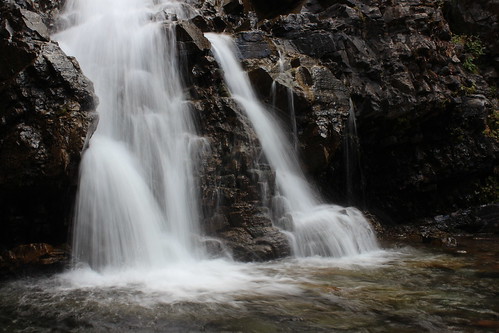
Morrell Falls, outside of Seeley Lake, is a classic western Montana hike, and now is one of the best times of the year to see it.
In the spring, beargrass grows thick in the open forest near the start and a torrent of whitewater cascades over the cliff at the end. In the fall, larch on the front of the Swan Range are golden and the water flows less voluminously, revealing more detail.
Recently, we set out from the parking lot northwest through the level forest, the floor covered in the remnants of spring's beargrass bloom. Slowly, larch began to appear - a yellow tree here and there among evergreens.
The route climbed a couple of short stretches, beginning near the halfway point, then passed two small lakes at about two miles. Here, stands of golden trees could be seen around the shore and up the side of Crescent Mountain.
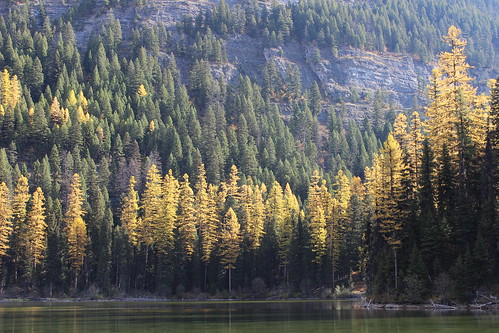
Just past the lakes, the trail crossed a bridge over Morrell Creek, curved back east at the foot of a steep hill and arrives at the falls.
After a break for some long-exposure photographs of the water streaming down the rocks and to let the dogs splash in the creek, we turned back to the trailhead.
The drive back to Missoula, past Salmon Lake and through the Blackfoot River canyon was equally as enjoyable, with more fall colors and bighorn sheep.
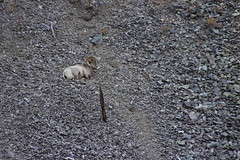
Here are more photos of Morrell Falls.
Distance: 5.2 miles round trip.
Trailhead: From the north edge of Seeley Lake, follow Morrell Creek Road east about 1 mile and then north about 5.7 miles. Drive east again 0.8 miles to the end of the road, turning north where it forks.
October 22, 2013
A fall 30K to finish my race year
I recently ran my first Blue Mountain 30K - Missoula's second longest race and a beautiful fall event!
The course climbs and descends the trails and forest roads of the Blue Mountain National Recreation Area on the southwest edge of town, gaining 3,500 feet of elevation and topping out at Hayes Point. Held in early October, the morning began brisk but warmed as the sun rose in the sky and the forest was awash in greens, yellows and oranges. (Speaking of oranges, the mimosa with a mile to go was a nice touch!)
After running most of the course in September with a couple of friends, I figured I'd finish in about 3 hours and 15 minutes. With about three miles to go on race day, I realized I had a chance at being under 3 hours. In the end, I crossed the line in 18th place overall at 2:53.35.
Blue Mountain was likely my final race of the year, but I'll be back at it in 2014 with some of my favorite events and, hopefully, some new ones.
October 9, 2013
Hiking Oregon's snow-covered crater country

There's something about us, travel and volcanoes - and snow.
We recently returned from Oregon, where we checked off a trip that's been on our list for a while: Crater Lake and the Shakespeare Festival in Ashland. The vacation with family from Portland had been in the works for a while, with reservations coming in the form of a gift last Christmas, but not everything went according to plan.
Days out from our arrival, the forecast called for partly to mostly cloudy skies with little chance for precipitation. The morning of our only full day in Crater Lake National Park, however, we saw our first snow of the season. When we woke the next day, a record 8 inches had piled up. As a result, the road around the rim was closed, cutting off access to several trails we had intended to hike, including to Mount Scott.

In recent years, it's never failed: If we're traveling to a volcanic area, there will be snow. Mount St. Helens had a dusting of snow when we climbed it. We've visited Yellowstone National Park several times, but only with snow on the ground. Then there was the storm in Iceland. OK, we probably should have expected that last one. Back to Oregon ...
We got a break in the weather the night we spent in Ashland, with only a brief rain shower during a performance of "Cymbeline" on the outdoor Elizabethan Stage at the Oregon Shakespeare Festival.
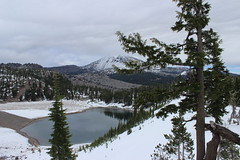
During our pass through Bend on the way home, however, we found more snow from the earlier storms and opted for indoor accommodations rather than camping. We had wanted to hike to the top of the South Sister, but it was socked in so we went partway up the trail to Moraine Lake instead. We also took in several sights at Newberry National Volcanic Monument.
A bit farther north, we stopped at Smith Rock State Park for a short walk to break up the drive home to Montana.
While we were able to get out despite the snow, we didn't hike as much as planned. Still, we enjoyed the journey and will have to return.
Crater Lake East Rim Drive
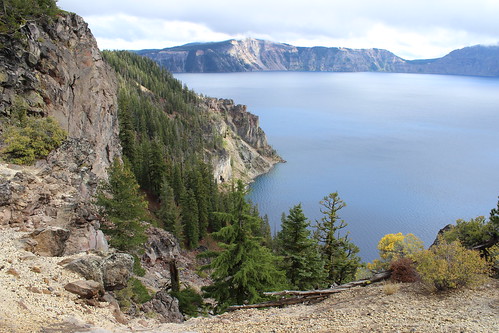
After driving from Portland - with stops in Salem for breakfast with friends and Eugene to visit a microbrewery - we arrived at Crater Lake National Park in the afternoon, as the sun was breaking through the clouds.
We took our time driving from the north entrance to the park around the east side of the rim to Crater Lake Lodge, where were staying. We didn't know it then, but it would be our only chance to see the lake during the trip.
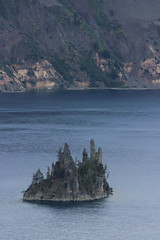
Along the way, we stopped to view Wizard Island, the Phantom Ship rock formation and Vidae Falls.
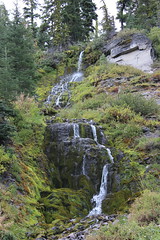
Here are more photos from the the drive into and out of Crater Lake.
Discovery Point
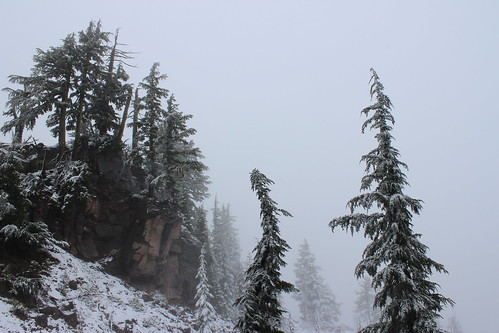
With snow falling steadily and the the rim drive closed the next morning, we set out on one of the few hikes available to us from Crater Lake Lodge.
Heading west from the lodge and roughly paralleling the West Rim Drive, the trail passes several overlooks of the lake - or clouds, in our case. Nonetheless, there were some interesting cliffs and snags, as well as some lingering wildflowers frosted over by snow.
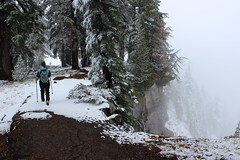
The trail continues past Discovery Point, but we turned around there and walked back to the lodge for lunch.
See more photos from Discovery Point.
Distance: 2 1/4 miles round trip.
Trailhead: Follow the paved path along the rim west from Crater Lake Lodge; it turns into a dirt trail as it leaves the parking area.
Annie Creek Canyon

That afternoon, we drove south and west down to Mazama Village - the name taken from the one given to the mountain that became the crater - where we found rain instead of snow, and a short hike along Annie Creek.
The trail loops along the top and through the bottom of the canyon containing the creek, beyond the campground on the west side of the village.
We started southeast along the top of the canyon, then turned back northwest as the trail dropped into it. Near the bottom, the view across the creek included some eroded rock features. Continuing northwest, the trail crosses the creek a couple of times before climbing back to the top of the canyon and the campground.
Here are a few photos of Annie Creek.
Distance: 1 3/4 miles round trip.
Trailhead: We parked in the lot just west of the Annie Creek restaurant and gift shop, but there is also limited parking available in Loop E at the campground.
Paulina Peak
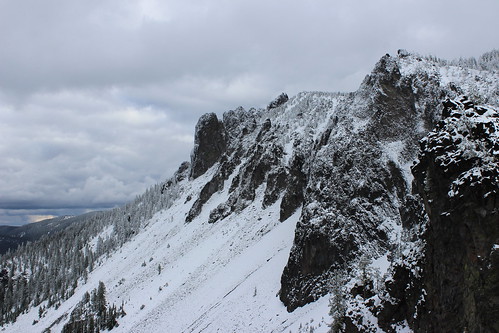
After leaving Crater Lake for a night in Ashland, we turned back north to Bend. Once we were checked in to our hotel, we returned to Newberry National Volcanic Monument south of the city in search of a trail.
We ended up in the Newberry Caldera area, where two lakes and an old lava flow sit below Paulina Peak. On the advice of a park staffer, we decided to hike through the snow to the summit.
The trail begins by climbing steeply through the forest to the southeast, occasionally offering views northwest toward Mount Bachelor and the Three Sisters.
Eventually, the forest thins and the trail skirts cliff edges below the peak, and over Paulina and East lakes and the old lava flow. The trail then returns to the ascent through the trees, before a final stretch along cliff edges to the top at 7,984 feet.
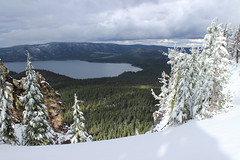
After carefully taking in the view near the top, we turned back to the car.
See more photos of Paulina Peak.
Distance: 4 miles round trip.
Trailhead: About 23 miles south of Bend, Ore., on U.S. Highway 97, turn east on Paulina Lake Road. Follow it about 13 miles, then turn south on Paulina Peak Road. The trailhead is past the end of the pavement, after about one-third of a mile.
Paulina Falls
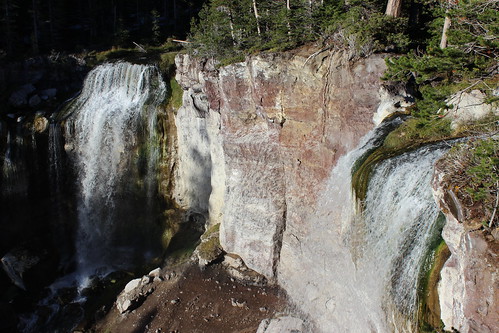
On the way back to Bend for the night, we stopped for a short walk to see the twin drops of Paulina Falls, viewable from above and below by short trails.
Here are a few more photos of Paulina Falls.
Distance: One-half mile round trip from the top of the falls to the bottom.
Trailhead: The parking are for the falls is 12 1/3 miles up Paulina Peak Road from U.S. Highway 97, 23 miles south of Bend.
Moraine Lake

Before leaving for Oregon, friends had pointed us toward the hike up the South Sister, which at 11 miles round trip and nearly 5,000 feet of elevation gain would have been possible given the initial forecast. With snow on the ground and the summit in the clouds, however, we opted to stay on the lower part of the hike and see Moraine Lake.
Starting at the Devils Lake Campground in the Deschutes National Forest, the route follows the South Sister Climber Trail north through the trees and across the highway. Here, the trail briefly meets Hell Creek as it cascades out of the forest.
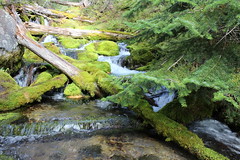
The trail soon enters the Three Sisters Wilderness and begins a steep climb through the trees - and snow at the time we were there. After about 1 3/4 miles, the trail levels and leaves the forest at a junction. Turning northwest, the route continues about a mile down open land with views of the South Sister and Broken Top to Moraine Lake.

After a break at the lake, we backtracked a short distance and followed a cutoff a little more than one-third of a mile east, back to the Climber Trail. About another quarter-mile up the trail to the north, a flat area provides 360-degree views of Moraine Lake below and the South Sister, Broken Top, Mount Bachelor and beyond.
With more clouds moving in from the north, we turned around here and followed the Climber Trail about 2 1/2 miles south, down through the snow and back to the trailhead.

See more photos of Moraine Lake.
Distance: 6 miles round trip.
Trailhead: Follow the Cascade Lakes Scenic Byway about 28 miles west of Bend and park at the trailhead at the Devils Lake Campground.
Smith Rock State Park

On the way back to Montana from Bend, we stopped for a short hike at Smith Rock State Park. While the park's colorful rock formations are a draw for climbers, there's also a good network of trails.
We started by crossing the Crooked River footbridge and climbing steeply to the northwest over the mile-long Misery Ridge Trail, taking in views from the cliffs along the way. Descending back to the Crooked River on the other side, the route passes the Monkey Face spire and connects with the Mesa Verde Trail for a quarter mile.
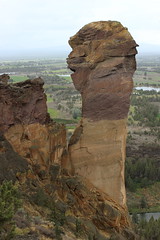
Out of the cliffs, we joined the River Trail, which rounds the rock formations southwest and then northeast for about 2 1/4 miles. Passing groups of climbers on the rock walls, we returned to the footbridge and then crossed to the parking area.
Here are more photos from Smith Rock State Park.
Distance: About 4 miles round trip.
Trailhead: In Terrebonne, Ore., follow B Avenue east from U.S. Highway 97 about 1 1/2 miles as it turns into Smith Rock Way. Turn north on Northeast 17th Street and continue one-half mile, then east on Northeast Wilcox Avenue and continue another half-mile. Turn north on Northeast Crooked River Drive and follow it about three-quarters of a mile into the park.
September 6, 2013
A long-weekend loop in the Swan Range

The long Labor Day weekend provided us the opportunity to take a three-day foray into the Swan Range, our dog Josey's first backpacking trip.
Our other dog, Belle, has been out on one-nighters before, but we haven't camped in the backcountry since Josey joined us about a year and a half ago. In anticipation of the trip, we outfitted her with a backpack to carry food for both dogs, which didn't slow her down in the slightest.
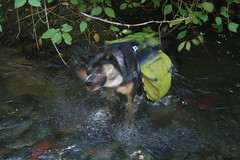
We began under a blue sky at Holland Lake, climbing along a creek to Upper Holland Lake then higher to Sapphire Lake, where we set up camp. The second day we hiked over a pass to Necklace Lakes in the Bob Marshall Wilderness and back. Clouds and a haze of wildfire smoke moved in during the day, and we saw a series of showers that night. The third day was considerably grayer, and we made quick work of packing up and hiking through a notch in the Swan Crest and back down to Holland Lake.
Having hiked into Sapphire on Sunday and out on Tuesday, the first night was quite crowded, but we had the place to ourselves the second.
Day 1: Holland Lake to Sapphire Lake

The hike begins by following Trail 415 east up through the forest above the north shore of Holland Lake. After passing a couple of junctions, the landscape opens up along a steep mountainside, providing a panoramic view of the lake and the Mission Mountains to the west.

After about 3 3/4 miles, the route crosses Holland Creek and continues up the drainage, joining Trail 35 that starts on the south side of the lake. The trail climbs past several small cascades and pools and crosses the creek again before leveling out and reaching Upper Holland Lake at about 6 3/4 miles, where we made a short stop and the dogs went for a swim.

From Upper Holland, the route turns northwest onto Trail 120 and climbs into more open, rocky forest that reveals the basin below and surrounding peaks. After about 1 2/3 miles, a short spur trail drops to Sapphire Lake.
Several campsites can be found around the lake, which sits high on the edge of the Holland drainage, most with beautiful views to the south and west. After wading across a narrow part of the lake to avoid a longer walk around, we set up our tent on a peninsula jutting in from the south.

The rest of the day was spent lounging on the rocky shore and taking in the view at sunset.
Here are more pictures of the hike up to Sapphire Lake.
Distance: 8 1/2 miles one way.
Trailhead: Trail 415 starts 20 3/4 miles north of Seeley Lake on Montana Highway 83, then 3 3/4 miles east on Holland Lake Road, just past Holland Lake Lodge.
Day 2: Necklace Lakes

The next day, we went on a short dayhike over Necklace Pass to Necklace Lakes in the Bob Marshall Wilderness.
From Sapphire Lake, Trail 120 continues west for a mile up to a forested junction, then turns north and climbs about one-third of a mile through a rocky valley to the pass, which provides views down both sides to the mountains beyond.

Turning northeast, the trail drops to a large lake that can be seen through a gap in the trees, then follows Smoky Creek to the shore of another lake about a mile from the pass. Here, we found a small, flat outcrop of land that made for a nice stopping point. Wildflowers were still blooming around the lake and kingfishers swooped through the sky as the dogs swam.

After a break, we hiked back up to the pass and down to Sapphire. With all of the other campers gone, we went for a swim that afternoon before rain clouds moved in later.
See more pictures from Necklace Pass and Necklace Lakes.
Distance: We hiked about 4 2/3 miles round trip, but the trail continues.
Day 3: Sapphire Lake to Holland Lake
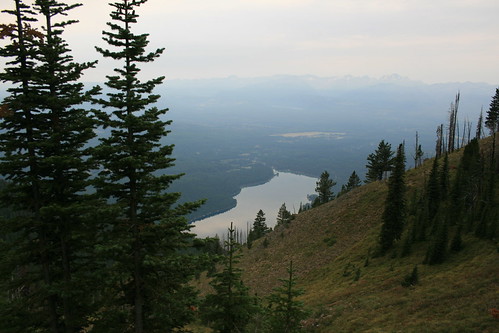
After a series of brief showers overnight and more clouds moving in, we decided to get an early start on our return to the trailhead on our third day.
To complete the loop, we hiked to the junction a mile west of Sapphire Lake on Trail 120, but instead of continuing up to Necklace Pass turned onto Trail 48 and switchbacked a short distance up to a notch in the Swan Crest. Here, the view of the Swan Valley opens, but with threatening clouds overhead we quickly continued downhill.
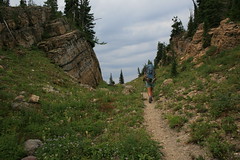
The trail switchbacks numerous times, first across the fairly open mountainside and past a junction with a trail to the site of the Holland Lookout, then into thicker forest. About five miles from the Trail 120 junction, the route returns to Trail 415 and levels somewhat as it reaches the floor of the valley.
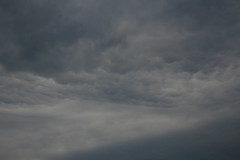
After another 1 1/3 miles, we were back at the Holland Lake trailhead and our vehicle. The rain held off just long enough for us to turn onto the highway for home.
Distance: 7 1/3 miles one way.
August 6, 2013
Belly River to Many Glacier, by shuttle and tunnel

After not backpacking in Glacier National Park last summer, we returned this year and were able to pick up a permit for a route that's been at the top of our list for a while: Up the Belly River and out to Many Glacier via the Ptarmigan Tunnel.
Over the years, we've been stymied in hiking this route several times. A few times, we've gone too early and the tunnel has been closed. More often than that, we've lost out in the advance reservation process and backcountry campsites have been full when we've tried to get a last-minute "walk-in" permit. This year, we didn't get our advance reservation request, but a couple of sites were still available the morning we arrived in the park.
As has become our habit, we spent the first day lining up details of the rest of our trip, going on a dayhike and settling in for the night at the St. Mary Campground.
After getting our backcountry camping permit in Apgar, on the west side of the park, we began the 50-mile drive over Going-to-the-Sun Road to the campground on the east side. Atop the always-packed Logan Pass, we parked in a pullout along the road, cut through the crowd and scrambled up Mount Oberlin with the mountain goats.

The next day, we spent the morning in the Many Glacier area, packing and waiting for a 1 p.m. shuttle to the Chief Mountain trailhead. It made for a late, hot start to our hike, but was the only time the van ran from where we parked at our exit point to our entry near the Canadian border. (I've written in the past about using the park service and Glacier Park Inc. shuttle systems to put together point-to-point trips and still encourage it - you'll see much more than on an in-and-out hike.)
About 2 p.m., we were dropped off at the trailhead and set out for a couple of nights at scenic Cosley and Elizabeth lakes, and a long, uphill hike through Ptarmigan Tunnel and back to our car.
Day 1: Mount Oberlin
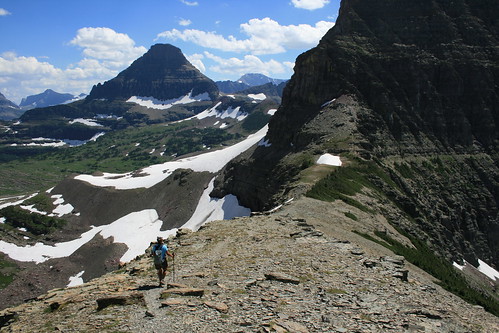
The 1,500-foot Mount Oberlin climb is one of the easiest in the park, but considering how popular the Logan Pass area is, it gets very little use. The only mention I've seen of it on the park website is on the trail/area closure page, but routes up it are described in the classic guidebook "A Climber's Guide to Glacier National Park."
Before setting out for Oberlin, we usually check with a ranger at the Logan Pass Visitor Center to make sure the area isn't closed due to sensitive plants. The trail begins a short distance northwest of the visitor center - look for the dirt track leading off the paved path behind a chain fence.
The route leads northwest through flower-filled meadows, up past a couple of small cascades on Logan Creek to a scree slope below Oberlin to the north and Mount Clements to the south. Here, the trail splits - the northern route climbs steeply through the scree, while the southern route ascends to the saddle between the mountains, then turns north and follows the rocky ridge.
We went up through the scree to reach the summit, where there are views out the McDonald and St. Mary valleys to the west and east, respectively, and across Clements to Mount Reynolds. At the top, we stopped to eat and were greeted by a mountain goat.
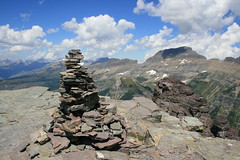
Having never taken the ridge route, we decided to try it on the way down. The footing is more stable, and the path fairly obvious if you pay attention to rock cairns. While it's not very technical, there are narrow ledges and a few spots that require lowering yourself down or pulling yourself up.
After passing a few more goats, we reached the saddle between Oberlin and Clements and scrambled - or, in my case, slid on the snow - back to the base of the scree slope. From there, we followed the trail to Logan Pass, stepping over the chain and back into the crowd.
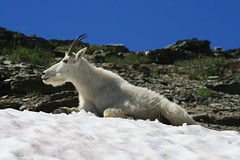
Here are more photos from Mount Oberlin.
Distance: About 3 miles round trip.
Trailhead: The trail begins off the paved path northwest of the Logan Pass Visitor Center, 32 miles northeast then southeast on Going-to-the-Sun Road from West Glacier.
Day 2: Chief Mountain to Cosley Lake

The next day, we parked our car at the Swiftcurrent Motor Inn and caught Glacier Park Inc.'s east-side shuttle from Many Glacier Hotel to the Chief Mountain trailhead, a couple of hundred yards shy of the Canadian border.
The trail begins by descending south into the Belly River Valley through a mixed pine and aspen forest. After three miles, the trail reaches the south bank of the river, then continues into and out of forests and meadows with views of Sentinel and Bear mountains to the west and Chief and Gable mountains to the east. It's an easy, rolling walk with little elevation gain or loss.

At about six miles, at the fence just before the Belly River Ranger Station, we turned west on the trail to Cosley Lake. A short distance later, we crossed the Belly River on a long suspension bridge, then climbed over a hill into the Mokowanis River drainage, taking in views back to the ranger station along the way. A little less than two miles later, we split off to see Gros Ventre Falls and the shady pool below it.
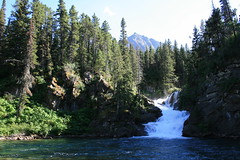
Back on the trail, we hiked a little more than three-quarters of a mile to the campground along the north shore of Cosley Lake. While each campsite was somewhat secluded in the trees just off the lake, all provided easy access to the pebble beach. After a hot afternoon of hiking, a swim in the cool lake relieved before dinner and a cloudless sunset with the last light glinting off Pyramid Peak, Mount Kipp, Cathedral Peak and others.

The next morning, I woke to see sunrise and the calm lake before we packed up again and headed back into the Belly River drainage.
Here are more photos from the trail to Cosley Lake.
Distance: 8 3/4 miles one way.
Trailhead: The Chief Mountain trailhead is a couple of hundred yard southeast of the U.S.-Canada border crossing on Montana Highway 17.
Day 3: Cosley Lake to Elizabeth and Helen lakes
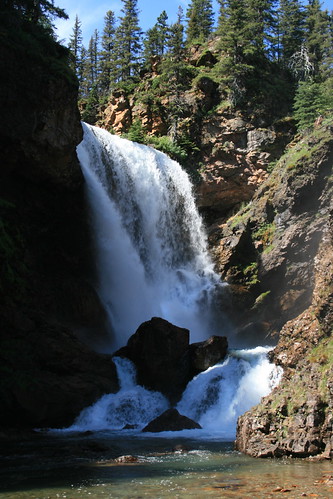
The next morning, we started at a leisurely pace - we didn't have a long or difficult hike ahead of us, although we did want to explore once we reached our campsite at Elizabeth Lake.
After backtracking east along Cosley Lake, we turned onto a cutoff trail at the outlet. There, hikers must ford the Mokowanis River with the assistance of a cable strung from one bank to the other. Crossing was fairly simple as the water wasn't that deep or swift; Jen wore sandals and I went barefoot after leaving mine in the car to cut my pack weight.
Once on the other side, we followed the trail into the forest, rounding Cosley Ridge to the south. The route began quite overgrown, but we soon came across a trail crew that was cutting back the underbrush. About two miles from the river crossing, we reached Dawn Mist Falls, where a short path leads to the Belly River below and the main trail offers a view from above after a brief climb.

The trail roughly follows the river for about the next 1 3/4 miles, where it reaches a camp at the foot of Elizabeth Lake. We continued south along the west shore of Elizabeth to the camp at the head of the lake, Natoas Peak towering overhead.
After we set up our tent, we decided to continue south up the valley toward Helen Lake. The trail passed along the river, providing a look at fish swimming in the calm pools. After a couple of creek crossings, it arrived at a meadow with a good view up to Old Sun Glacier.
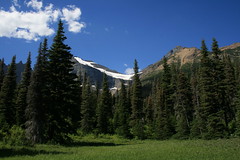
A short distance uphill and we arrived at the outlet of Helen Lake, crossing the creek and continuing on to the shore. The turquoise waters, fed by Ahern Glacier and other snowfields, made for a chilly swim, but we had plenty of time to relax on the gravelly beach afterward.
On the way back to camp, clouds began to build up, and they continued through dinnertime and after sunset. While rain wouldn't be a bother, thunderstorms could complicate the next day.
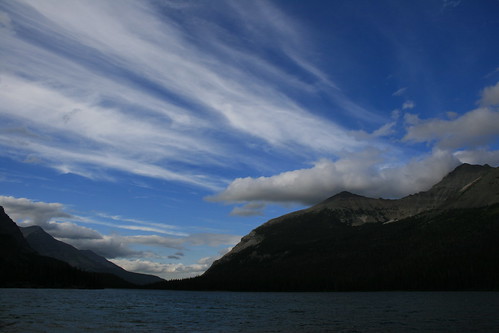
Here are more photos from Dawn Mist Falls, and Elizabeth and Helen lakes.
Distance: 5 3/4 miles one way to the head of Elizabeth Lake. Helen Lake is a little less than 5 1/2 miles round trip from there.
Day 4: Elizabeth Lake to Many Glacier
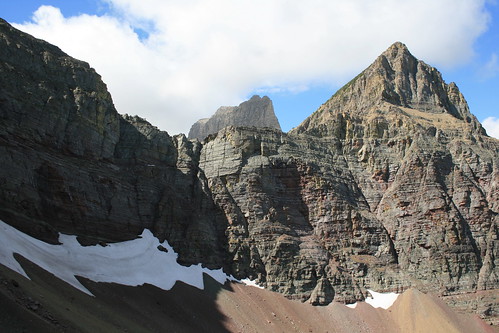
Our last morning in the park, we woke to fairly cloudy skies, hoping they would clear as we had our longest, most strenuous hike ahead of us. Before we started our trip, the forecast had been for thunderstorms to move in late that afternoon - any earlier and we could be forced to re-evaluate our route out through the mountains.
After an early breakfast, we set out back around the lake, spotting a fresh set of moose tracks at the water's edge along the way. At the outlet, we crossed a suspension bridge over the Belly River and began the 2,500-foot climb south up to Ptarmigan Tunnel.
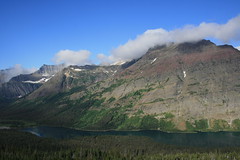
Here, the trail steadily switchbacks up through the forest before reaching the junction for Redgap Pass and continuing across the mountainside. The pine forest started out tall but grew shorter higher on the trail, eventually disappearing along with any other foliage. With the clouds mostly gone, the views from above the valley extended from the Belly River to the north, across Elizabeth Lake to Natoas Peak, and southwest to Helen Lake and Ptarmigan Wall.
The trail continued across an open, rocky slope, turning into the towering peaks and hugging the side of a cliff. With all the climbing, we were fortunate to be on the shady side of the mountains. At the tunnel, about 4 3/4 miles above the lake, marmots scrambled among the rocks and we began to encounter an abundance of hikers who had started from the Many Glacier side.

Once through, we found ourselves in the warm sun, and after eating, we switchbacked down to Ptarmigan Lake, where the trail returned to the forest. Another 1 3/4 miles down through the trees and we arrived at the junction with the Iceberg Lake trail and, shortly thereafter, the small Ptarmigan Falls.
Most of the nearly 2 1/2 miles back down the trail from there was uneventful, with only a few views of Mount Wilbur and the Wilbur and Swiftcurrent creek drainages. For the most part, we were hiking against the crowd on their way up to Iceberg Lake, one of the most popular trails in Glacier.
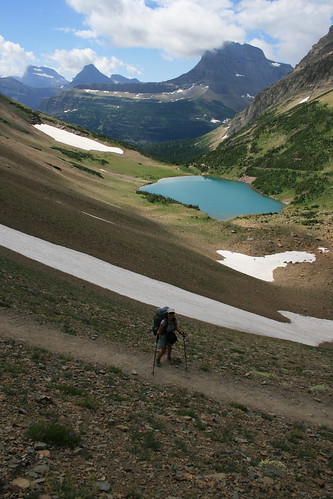
Back at the trailhead, it was a short walk down the road to the Swiftcurrent Motor Inn, where our car was parked. We arrived with storm clouds towering overhead and a few drops of rain falling to the ground - a good time to head home!
Here are more photos from the hike through Ptarmigan Tunnel.
Distance: 11 3/4 miles one way.
Trailhead: The trailhead for Ptarmigan and Iceberg lakes is on the northwest side of road around the Swiftcurrent Motor Inn complex in the Many Glacier area.
Subscribe to:
Posts (Atom)